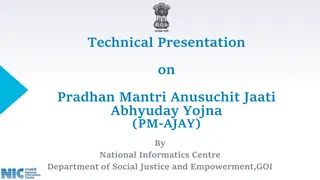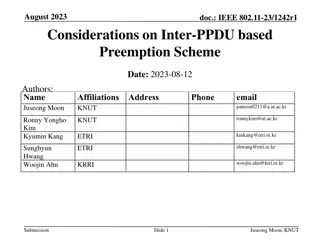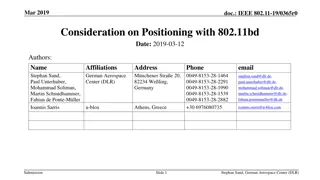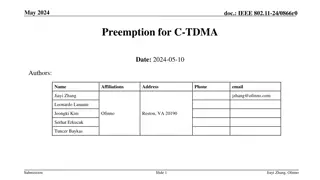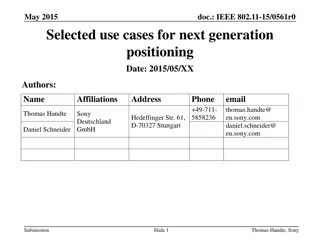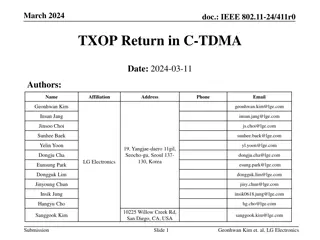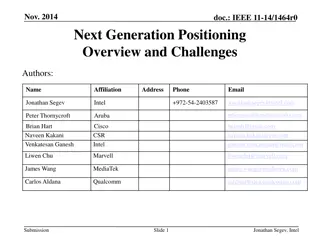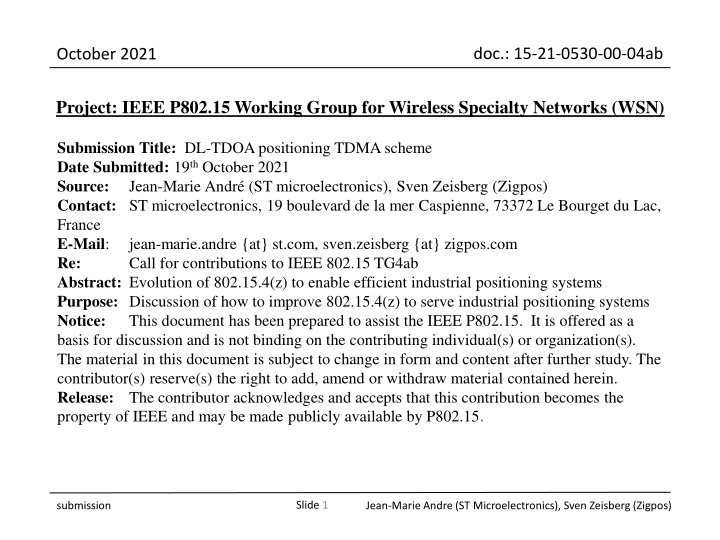
Enhancements of IEEE 802.15.4(z) for Industrial Positioning Systems
Explore the submission discussing the evolution of IEEE 802.15.4(z) to enhance industrial positioning systems with a focus on DL-TDOA positioning and TDMA scheme. The proposal aims to ensure compatibility, interference mitigation, coexistence improvement, backward compatibility, accuracy enhancements, reliability, reduced complexity, and more for efficient industrial positioning systems.
Uploaded on | 0 Views
Download Presentation

Please find below an Image/Link to download the presentation.
The content on the website is provided AS IS for your information and personal use only. It may not be sold, licensed, or shared on other websites without obtaining consent from the author. If you encounter any issues during the download, it is possible that the publisher has removed the file from their server.
You are allowed to download the files provided on this website for personal or commercial use, subject to the condition that they are used lawfully. All files are the property of their respective owners.
The content on the website is provided AS IS for your information and personal use only. It may not be sold, licensed, or shared on other websites without obtaining consent from the author.
E N D
Presentation Transcript
doc.: 15-21-0530-00-04ab October 2021 Project: IEEE P802.15 Working Group for Wireless Specialty Networks (WSN) Submission Title: DL-TDOA positioning TDMA scheme Date Submitted: 19th October 2021 Source: Jean-Marie Andr (ST microelectronics), Sven Zeisberg (Zigpos) Contact: ST microelectronics, 19 boulevard de la mer Caspienne, 73372 Le Bourget du Lac, France E-Mail: jean-marie.andre {at} st.com, sven.zeisberg {at} zigpos.com Re: Call for contributions to IEEE 802.15 TG4ab Abstract: Evolution of 802.15.4(z) to enable efficient industrial positioning systems Purpose: Discussion of how to improve 802.15.4(z) to serve industrial positioning systems Notice: This document has been prepared to assist the IEEE P802.15. It is offered as a basis for discussion and is not binding on the contributing individual(s) or organization(s). The material in this document is subject to change in form and content after further study. The contributor(s) reserve(s) the right to add, amend or withdraw material contained herein. Release: The contributor acknowledges and accepts that this contribution becomes the property of IEEE and may be made publicly available by P802.15. Slide 1 Jean-Marie Andre (ST Microelectronics), Sven Zeisberg (Zigpos) submission
doc.: 15-21-0530-00-04ab October 2021 PAR Objective Safeguards so that the high throughput data use cases will not cause significant disruption to low duty-cycle ranging use cases Proposed Solution (how addressed) Interference mitigation techniques to support higher density and higher traffic use cases Other coexistence improvement Backward compatibility with enhanced ranging capable devices (ERDEVs) The proposed scheme is backward compatible with ERDEVs. Improved link budget and/or reduced air-time Additional channels and operating frequencies Improvements to accuracy / precision / reliability and interoperability for high-integrity ranging Reduced complexity and power consumption Hybrid operation with narrowband signaling to assist UWB Enhanced native discovery and connection setup mechanisms The proposed scheme is enabling increased reliability for industrial environments. Sensing capabilities to support presence detection and environment mapping Low-power low-latency streaming Higher data-rate streaming allowing at least 50 Mbit/s of throughput Support for peer-to-peer, peer-to-multi-peer, and station-to- infrastructure protocols The proposed scheme supports infrastructure based positioning systems. Infrastructure synchronization mechanisms The proposed scheme supports adding low energy consumption anchor nodes in DL-TDoA. Slide 2 Jean-Marie Andre (ST Microelectronics), Sven Zeisberg (Zigpos) submission
doc.: 15-21-0530-00-04ab October 2021 To motivate compatible enhancements of 802.15.4(z) a scalable TDMA based access scheme description for industrial positioning systems is provided for discussion, which is: enabling DL-TDOA as well as UL-TDOA to co-exist in a given area, enhancing positioning reliability by avoiding ranging collisions, allowing full featured anchor nodes and battery powered anchor nodes deploying block based communication and ranging based creative deployment of legacy 802.15.4(z) toolbox Slide 3 Jean-Marie Andre (ST Microelectronics), Sven Zeisberg (Zigpos) submission
doc.: 15-21-0530-00-04ab October 2021 Interest & Challenges of DL-TDoA DL-TDoA can be viewed as GPS substitute allowing smart devices to compute their location, with substantial improvement over GPS: Works indoors and wherever a network of satellites (anchors) is deployed High precision High refresh rate Unlimited number / density of smart devices, as they don t transmit Yet, DL-TDoA comes with some challenges: Scalability: the synchronization mechanism must be suited to address any constellation of satellites UL-TDoA compatibility: leverage a synchronous infrastructure to also locate tags Cost of deployment: more than the cost of a satellite itself, the cost of wiring it is a serious impairment Slide 4 Jean-Marie Andre (ST Microelectronics), Sven Zeisberg (Zigpos) submission
doc.: 15-21-0530-00-04ab October 2021 We are proposing a slight adaptation of the round structure as defined in 4z Slide 5 Jean-Marie Andre (ST Microelectronics), Sven Zeisberg (Zigpos) submission
doc.: 15-21-0530-00-04ab October 2021 2 options are taken: a) Don t use the measurement report phase in order to improve recurrence b) Extend the ranging control phase to allow multiple controllers to co-exist Slide 6 Jean-Marie Andre (ST Microelectronics), Sven Zeisberg (Zigpos) submission
doc.: 15-21-0530-00-04ab October 2021 This is minimizing the evolution compared to 4z: from a local standpoint, the structure is in line with 4z. Slide 7 Jean-Marie Andre (ST Microelectronics), Sven Zeisberg (Zigpos) submission
doc.: 15-21-0530-00-04ab October 2021 From a system standpoint, this allows to have multiple controllers synchronized This ensure a scalable synchronization, enabling DL-TDoA across a wide space There is no concept of clusters, as everybody is on the same clock Slide 8 Jean-Marie Andre (ST Microelectronics), Sven Zeisberg (Zigpos) submission
doc.: 15-21-0530-00-04ab October 2021 As in 802.15.4z, the Ranging Phase is split in 2 parts: Initiation Response The Initiation part of the ranging phase is dedicated to downlink messages. It is used exclusively by fixed anchors, aka satellites. It is sufficient to enable DL-TDoA. The Response part is left for mobile devices aka tags, to transmit uplink. A number of location possibilities are thus enabled: UL-TDoA, TWR, RToF, etc. Slide 9 Jean-Marie Andre (ST Microelectronics), Sven Zeisberg (Zigpos) submission
doc.: 15-21-0530-00-04ab October 2021 In this approach, anchors are designating the fixed parts of the location system. We call them satellites and we make the difference between 2 types: Full Blown Satellites are regular anchors, they are connected to the mains and can receive a much as needed. Battery Powered Satellites are not connected to the mains. They are easy to install and very useful to densify a place where accurate DL-TDoA is needed. For such devices, the reception time must be minimized, in order to save power and maximize lifetime. To achieve this mix, roles are split based on power consumption profiles: Battery Powered Satellites are only involved in the Initiation Phase, they transmit during the first slots of the Initiation Phase. Full blown satellites are active in the Control Phase, as well as in the last slots of the initiation phase. Slide 10 Jean-Marie Andre (ST Microelectronics), Sven Zeisberg (Zigpos) submission
doc.: 15-21-0530-00-04ab October 2021 Full Blown Satellites: RCP + Init Uplink Battery Powered Satellites: Init only Slide 11 Jean-Marie Andre (ST Microelectronics), Sven Zeisberg (Zigpos) submission
doc.: 15-21-0530-00-04ab October 2021 Full Blown Satellites monitor the init messages of their neighbours and transmit a list of time corrections to be applied Battery Powered Satellites do not set their receiver at every round => Init messages may drift Uplink Slide 12 Jean-Marie Andre (ST Microelectronics), Sven Zeisberg (Zigpos) submission
doc.: 15-21-0530-00-04ab October 2021 Background behind this proposal Sven & Jean-Marie are part of omlox, where they defined an open standard to enable UWB tracking in industrial context omlox v1 was implemented several years ago and offered both TWR and DL-TDoA capabilities. It was deployed in various industrial compounds in Europe & US We found that in harsh environments, a higher density of anchors was needed. That is where the concept of Battery Powered Satellite was crafted. This concept and the rest of this presentation are part of the definition of omlox v2, whose release is due by the end of this year. This disclosure was authorized by the board of omlox Slide 13 Jean-Marie Andre (ST Microelectronics), Sven Zeisberg (Zigpos) submission
doc.: 15-21-0530-00-04ab October 2021 Thank you for your kind attention. Are there any questions? Slide 14 Jean-Marie Andre (ST Microelectronics), Sven Zeisberg (Zigpos) submission








